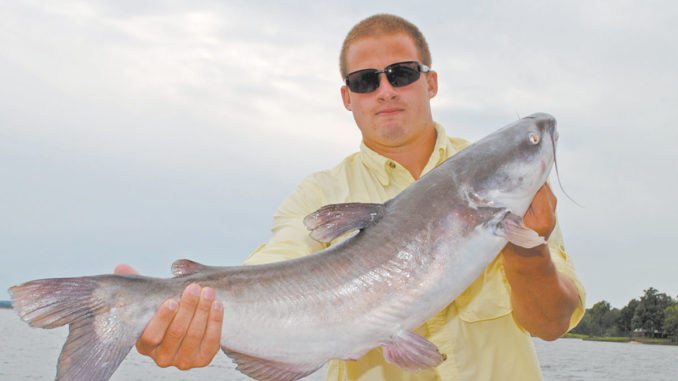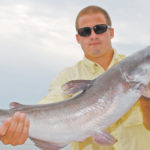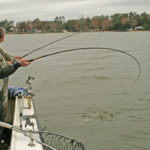
When baitfish ball up this month, action is great
The weather will be cool in December, but the fishing at Santee Cooper typically get’s hot for at least a couple of species: striper and catfish.
The striper fishing is among the best of the year in terms of quality and quantity of fish caught. Plenty of keeper-sized stripers should be in the creel, and a lot of fish that are just short of the size limit will have to be released, but catching and releasing fish in the 8-pound class can be a lot of fun.
Guide Leroy Suggs has fished Lake Marion and Lake Moultrie for years and focuses his attention specifically on stripers this month.
“December is an excellent month for stripers, particularly big stripers,” Suggs said. “One thing I enjoy is that there are two different ways to catch these fish. One that is very exciting is when the stripers are schooling on topwater, and the other is drift fishing using live bait.”
Suggs (910-995-1168), who guides out of Blacks Camp, primarily fishes Lake Moultrie. He said that both lakes have excellent striper fishing at this time of year, so either lake will normally be productive.
“December usually offers a little something different on Lake Moultrie in that most years, there are scads of menhaden near the Pinopolis Dam, and they can be caught and used as bait,” he said. “I prefer them about the size of a small bream, about three fingers wide.
“When using live bait such as menhaden — or blueback herring if you can’t get menhaden — is to work the humps and ridges of Lake Moultrie in 10 to 50 feet of water,” Suggs said. “Time of day, cloud cover and wind can all play a role in how deep the fish are found, but the most important key is the forage. If you find the forage, either menhaden or other forage, you will find stripers.
“To catch them, I go upwind of where I marked them on my graph and drift back over the school,” Suggs said. “I’ll fish at the level I mark the fish or just slightly above. My primary tackle is a 7-foot Ugly Stick with an Ambassador 5500 reel loaded with 17-pound line. I use a very small hook, a No. 1 Eagle Claw wide-gap hook on a 3-foot leader. Above the leader, I use a 2-ounce weight. This small hook enables the bait to be lively, the hook is less visible, and it will impact how many fish you hook.”
Suggs said that odds are good to find fish schooling on topwater early and late and at most any time on cloudy days.
“For schooling fish, I’ll use a 1/2- or 3/4-ounce bucktail,” he said. “I use a white head with red eyes and a white body bucktail. I typically use a Sea Striker, but a lot of bucktail varieties will work fine. I do recommend to sometimes use the heavier lure and allow it to drop a bit deeper before you start reeling it in, because the larger, keeper-sized stripers will often be beneath the surface feeding fish.”
Guide Alan Spence said that the catfishing is typically great this month, but much of the success and specific tactics used will be weather dependant.
“Simply put, the colder it gets, the better I like it,” Spence said. “When we get a cold December that causes shad to get into tight groups, it makes finding and catching blue catfish easier. If it’s really cold, the action on flatheads slows way down, so most guides focus on the blue catfish.”
Spence (803-983-8284) said the reason he prefers a cold December is that when the water is warmer, the shad are scattered — and so are the catfish.
“You’ll simply have to move more to catch catfish until the water gets really cold,” he said. “One good thing I’ve noted throughout the late summer and fall of 2013 is that we’ve had a really good hatch of threadfin shad this year, and I think that bodes well for our winter fishing.”
“My favorite technique is to find the big schools of shad,” Spence said. “Then I do something a little different than some, I’ll move a little bit away from the shad and see if I can mark some big fish near the bottom that I believe are catfish. I set up on those fish, and usually it works pretty well. My bait is not competing with the natural bait, but I stay close because the blues will be close or under the big schools of shad. Odds are good you’ll hook up quickly when you can find this situation.”
Spence said he will use down rods, flatlines or drift fishing depending on the conditions.
“Sometimes I’ll be able to get right over the fish and can drop my bait straight down,” he said. “But if that doesn’t work, I’ll cast multiple rods out in a flat-line manner, but I have to anchor both ends of the boat when doing this. If there’s a breeze and the area is not too full of snags, I sometimes have success drift-fishing. I’ll change tactics until I find out what the fish want on any given day. My preferred bait is threadfin or gizzard shad.”
Spence also keeps rigs ready for striper fishing because often, even when looking for catfish, he’ll find fish suspended at a depth that’s ideal for stripers.
Some days I do fish specifically for stripers, but even on days when clients want to catfish, I stay ready for the stripers,” Spence said. “During December, you can find a big school of hungry stripers at any given time, especially when using live bait.







Be the first to comment